
One of the proudest moments you’ll ever have in the kitchen, is looking back at your many jars of canned goods – made exclusively by you!
If you’ve ever been able to can 30 jars of tomato sauce all from your own garden, go ahead and consider that an excellent feat!
Continue adding to your canning repertoire each summer and keep moving forward from there.
If you haven’t had much success in canning yet, keep trying. With experience you will achieve fantastic results.
Rhubarb jam, brandied cherries, bilberry syrup, spicy zucchini pickles, mango salsa… Make sure they all have a special place on your shelves, even if you didn’t grow the ingredients yourself.
While growing everything you need in a survival garden works well for some people, it is certainly not a reality for the masses.
If you have access to farmers markets, receive excess produce from friends and neighbors, or have the means to buy what you need from the supermarket, then you are well on your way to having enough raw material to can.
With plenty of canning jars, a water bath canner (or a large pot), a pinch of canning knowledge and plenty of inspiration, you will be ready to make this canning season a superior one!
To discover enticing jars of homemade goods on your pantry shelves, start collecting recipes for canning, and be sure to think as diversely as possible.
Homemade jams and jellies
Once you get into canning, you’ll find that it is easiest to start with preserving fruit.
Keep in mind that no pantry is complete without a diverse selection of homemade jams, made with fruits that are very forgiving.
Making jam is very simple. Too sour? Add a touch of sugar. Too watery? Let it boil longer, never forgetting to stir.
Choose your favorite fruit, or the one you have the most of (hopefully they are one and the same) and get that wooden stirring spoon ready!
1. Blackberry jam
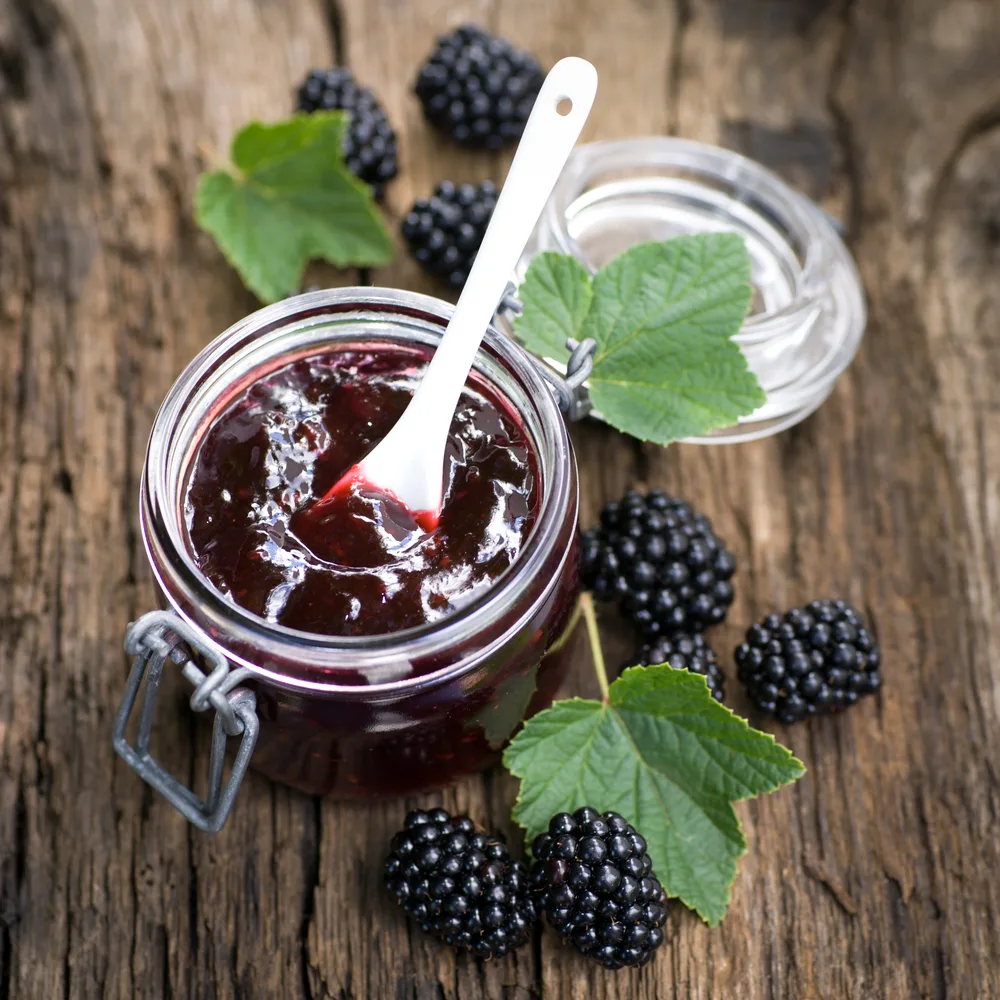
With seeds, or seedless, the blackberry jam you decide to make is entirely up to you and your level of refinement.
Just remember to harvest a minimum of two pounds of blackberries for this canning project. Any less and it will be over far too quick. If you can scale it up to 4 pounds or more, you will have extra jars of homemade blackberry jam to give as gifts – and more for yourself too.
2. Strawberry jam
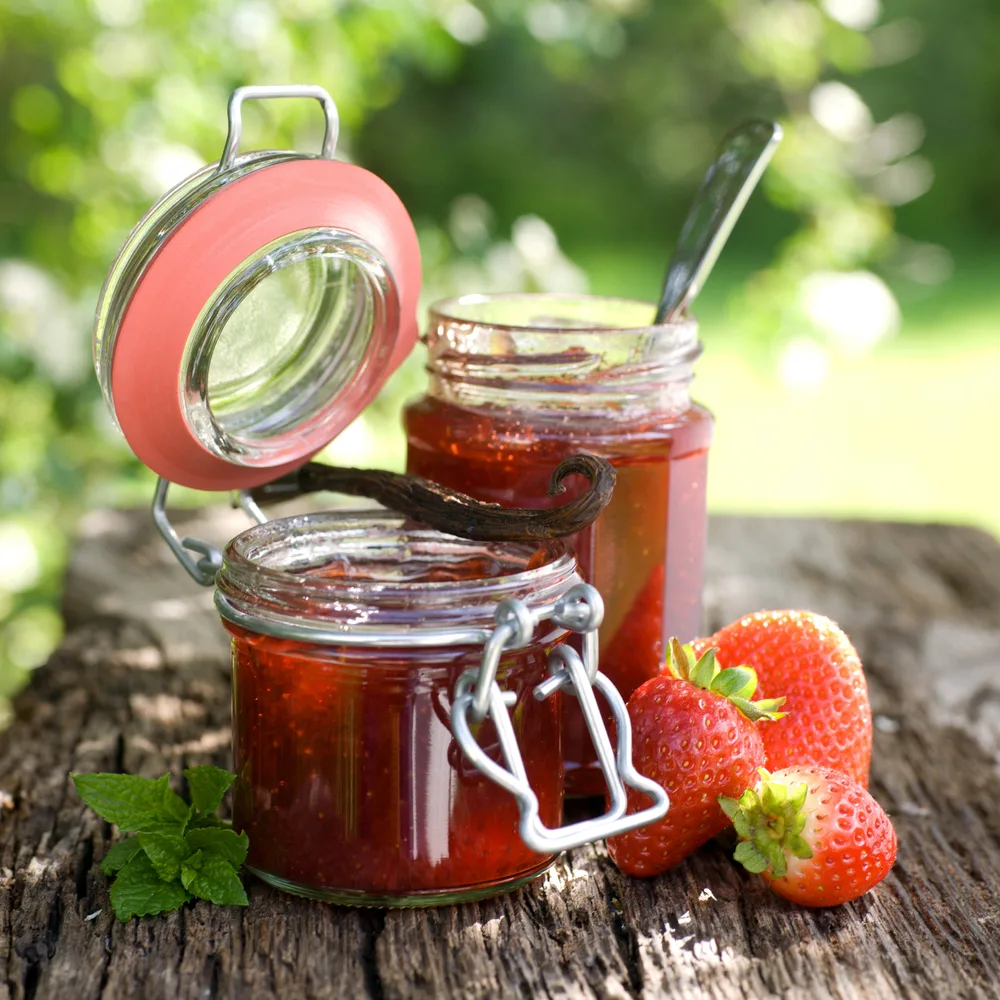
Why opt for the classic sugary strawberry jam, when you can make it healthier with honey instead?
Honey sweetened strawberry jam (without pectin) is like nothing you will ever buy from a store. It is far better!
Though you may need some time to get used to the differences. It will never be as thick as store-bought for instance. Turn this around into thinking of your homemade jam as having a softer result and you will love it even more.
If you have been searching for sugar-free canning options, this is an amazing one.
3. Rhubarb jam
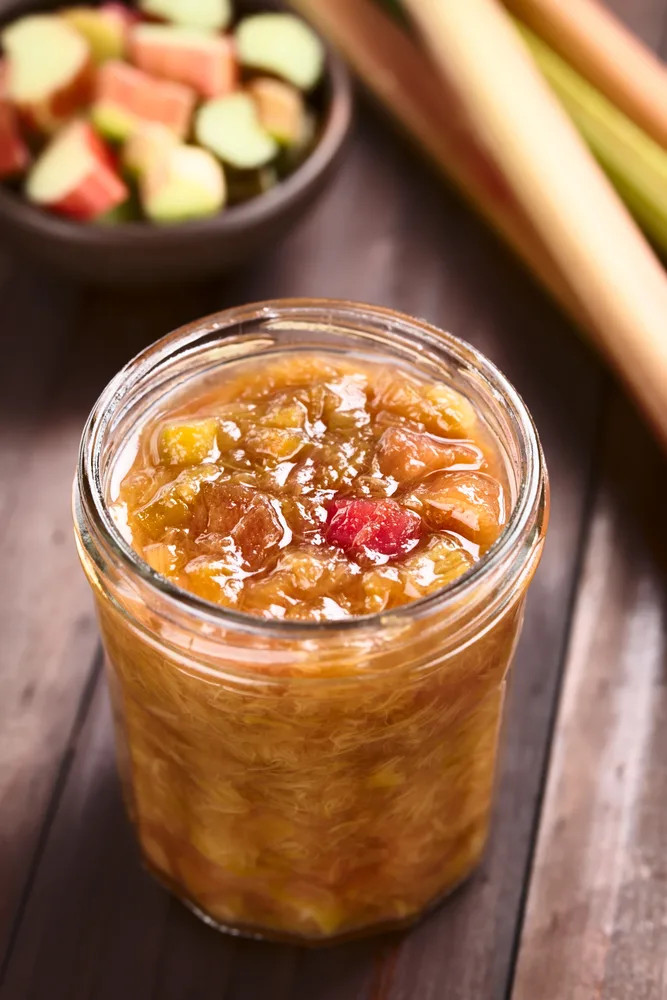
One of the greatest perennials to grow in your garden is rhubarb, provided you enjoy the earthy flavor, that is.
Only the harvest season tends to be short and in a couple of bursts. Freezing is the most common way to preserve rhubarb, though canning is wise as well. It can still provide you with plenty of stock for making rhubarb cobblers throughout the year.
Rhubarb jam can be made with low sugar, or with more, depending on your preference. It can also be made with pectin, or without. Here are 3 ways to can rhubarb jam.
4. Vanilla peach jam
Peach jam is always a popular treat, especially when spooned over a bowl of vanilla ice cream.
If that flavor combination suits your taste buds, and you have plenty of peaches to experiment with this year, vanilla peach jam should be a new and exciting recipe to try.
Don’t sell this recipe short with vanilla flavoring, splurge and go for real vanilla beans, every bite will be worth it.
5. Apricot jam
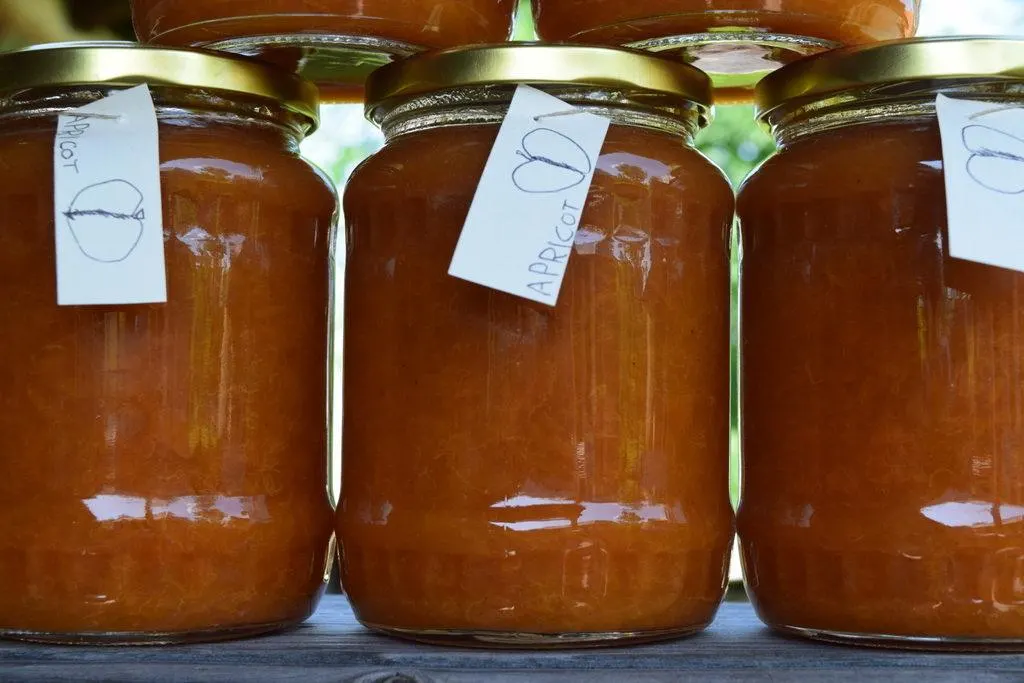
Recipes for making jam tend to include a lot of sugar. Often in a 50:50 ratio.
But, it doesn’t have to be this way. In fact, you can make some jams with absolutely no sugar at all. One of our favorites is sugar-free apricot jam. It is slightly acidic, beautifully tart and it keeps its amazing color for years after canning.
Like traditional plum jams, with nothing but the plums, apricot jam is a must-make this season. Especially if you would like to take a break from too much sweetness.
In the end, if you find it not sweet enough, you can always add a small spoonful of raw honey to the amount of jam you are using from the jar.
6. Dandelion jelly
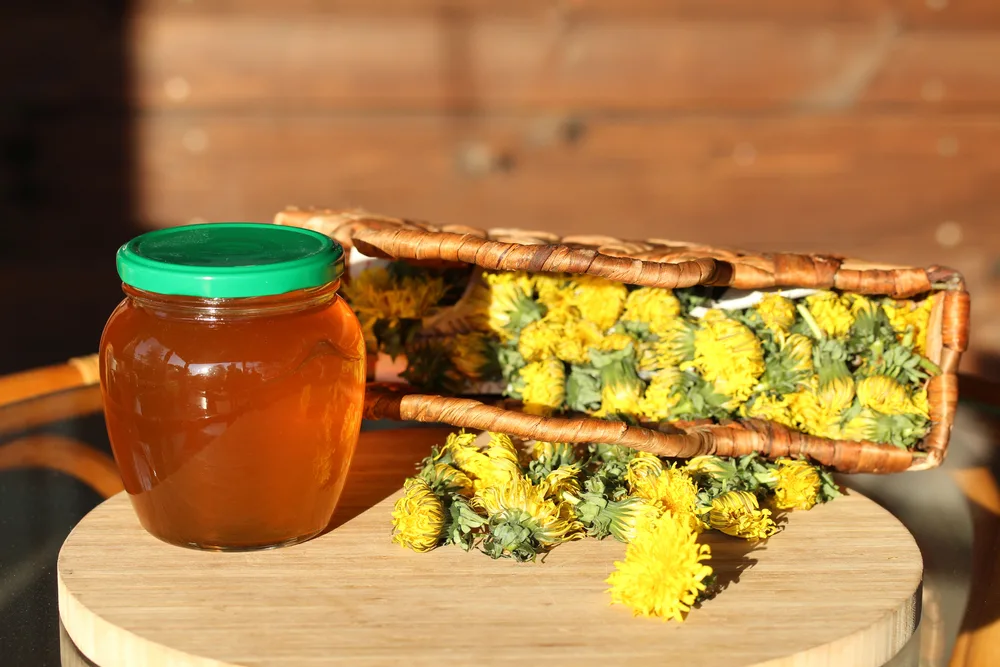
One of the first spring greens to forage for, is dandelion leaves. Then come the bright yellow dandelion flowers, and the great debate on whether we should leave them all for bees, or if it is okay to harvest some for ourselves.
Balance is always key in harvesting from the wild. Best of all, stop spraying chemicals and leave wildflower meadows instead of lawns.
If you have a safe place to harvest dandelion flowers aplenty, you could try making dandelion jelly, or dandelion mead.
Either way, those flowers will be put to good use, with plenty leftover for the bees!
7. Corn cob jelly
If you are searching for something unusual to spice up your shelf, or a way to use up your leftover corn cobs, corn cob jelly could be just the recipe you need.
You can spread it on crackers with butter for a winter-summer garden treat. Serve it with pancakes or oven-hot biscuits, and it can be used as a glaze for chicken, pork roast or ham. Corn cob jelly will help you get more creative in the kitchen, there is no doubt about that.
8. Jalapeño jelly
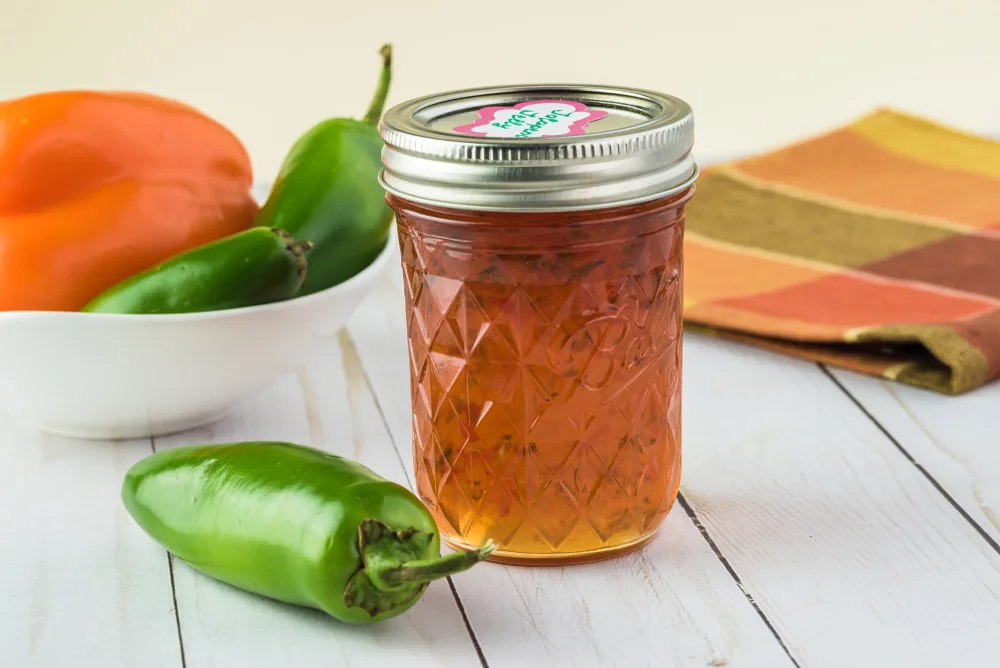
If you are someone who thinks a little bit of spice is nice, but a lot of spice is a whole lot better, then you are going to want to try this jalapeño jelly the next chance you get.
It is intense, it is exhilaratingly tasteful and it is a dream to dig out a jar of spicy summer days on a cold winter one.
Spread on sandwiches, add a dollop to cheese and crackers, spoon it over your grilled chicken. The possibilities are endless – and my mouth is already watering because of it.
Pickles and chutneys
One year we were a bit overzealous and managed to can almost 250 jars of jam! Not little jars either, 26 oz. jars.
This was possible, thanks to a bumper crop of apples, plums and apricots in a single summer. We just couldn’t let the goodness go to waste, knowing that fruit crops are cyclical in nature.
And true to that cyclical nature, we had just a decent crop of apples the following year, and nothing else.
The downside to this, is that we were so busy making jam, that when winter arrived and we became tired of eating homemade preserves (yes, it can happen!), we realized just how important pickles and chutneys were. We blazed through 20 jars at lightning speed.
Having a well-stocked pantry means having a little of everything, for the sake of diversity and entertainment. Without further ado, here are some tart, sour and salty items to add to your list of canning recipes to try this summer.
9. Dill pickles
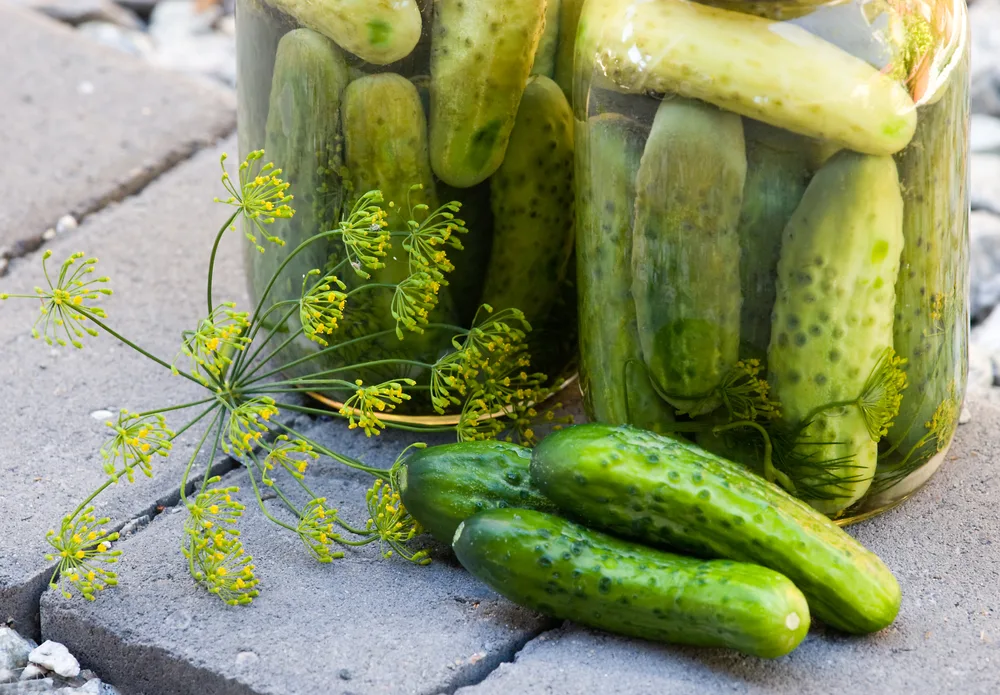
It is always fun to experiment with unique and interesting recipes. However, if you must can one classic, make it dill pickles.
There are so many canning recipes for pickles out there, how do you choose the best one?
In my experience, it is best to accept that pickles may taste slightly different each year. No matter how hard you try to get the same flavors, it will never happen like with buying store-bought pickles.
Embrace the seasonal flavor difference and try a couple of pickle recipes at a time, until you find one that you enjoy. Use different spices and herbs, add garlic and hot pepper, maybe some mustard seeds – just have fun with it!
Here are some dill pickle recipes to get you started:
Granny’s Bread and Butter Pickles Recipe
10. Zucchini pickles
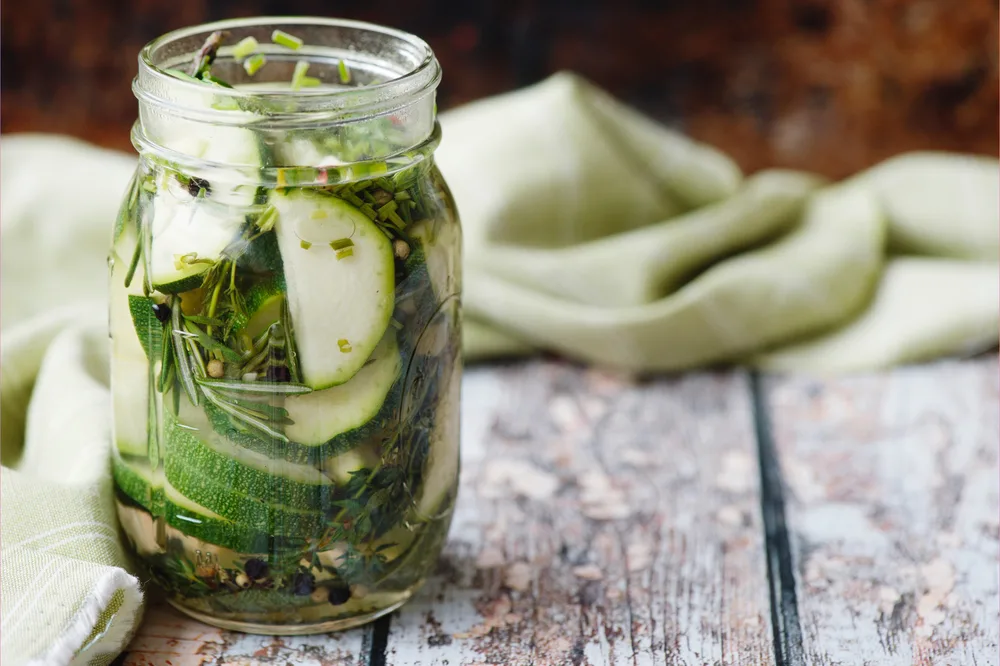
Say your cucumbers don’t grow very well, though your zucchini acts like it wants to grow out of the garden. Stop it before it is too late! Make zucchini pickles instead.
It is easy to make refrigerator zucchini pickles, but they won’t last very long. And if you have a lot to can, this may not be your best option.
Can these sweet and sour zucchini pickles instead. They are made with onions, apple cider vinegar, sugar, yellow mustard seeds, turmeric, celery seeds and black peppercorns. A tasty treat indeed.
11. Zucchini relish
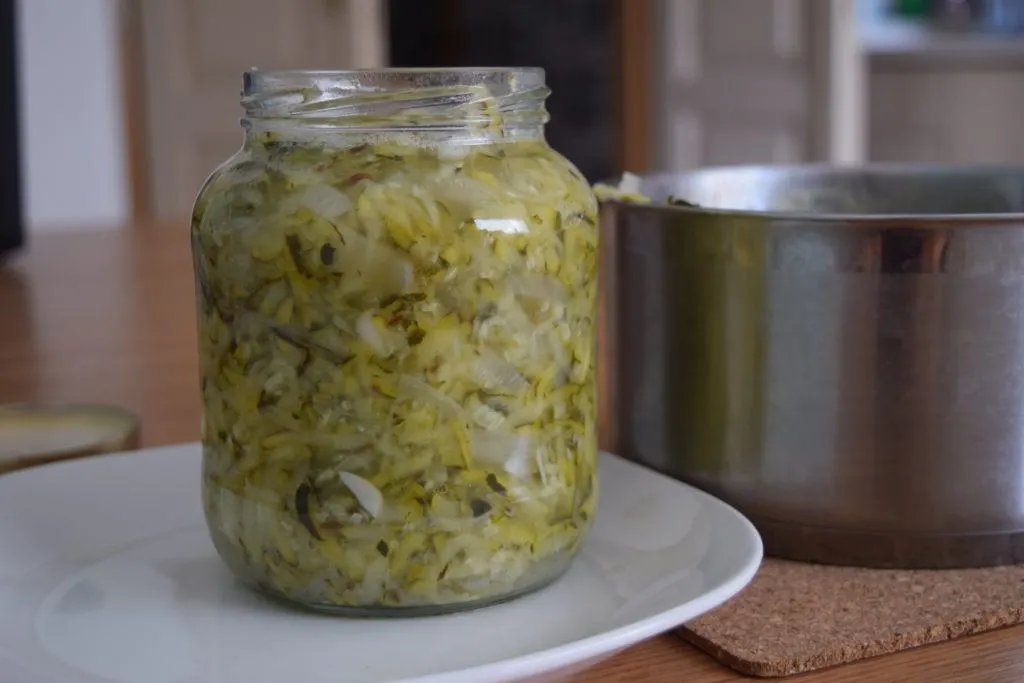
If your zucchinis seem a bit too large to can, consider grating them into relish instead. This is a perfect way to use up oversized fruits, outside of walnut-raisin zucchini bread, that is.
It is super easy to make a large batch of savory zucchini relish, that can last all winter long. Serve it on burgers, alongside roasts, or with a plate of cheese and crackers.
12. Pickled beans and garlic
Why can’t you find pickled green beans at the store? They only answer I have, is that if you want them, you have to make them for yourself. This rings true for many homegrown foods.
Industry churns out a lot of products, but for something truly special, it is best made by your hands. Better yet, with beans from your own garden.
If you have been looking for a safe way of preserving your beans, outside of freezing them, go ahead and try this spicy garlic and dill pickled beans recipe. You won’t be disappointed.
13. Pickled beets
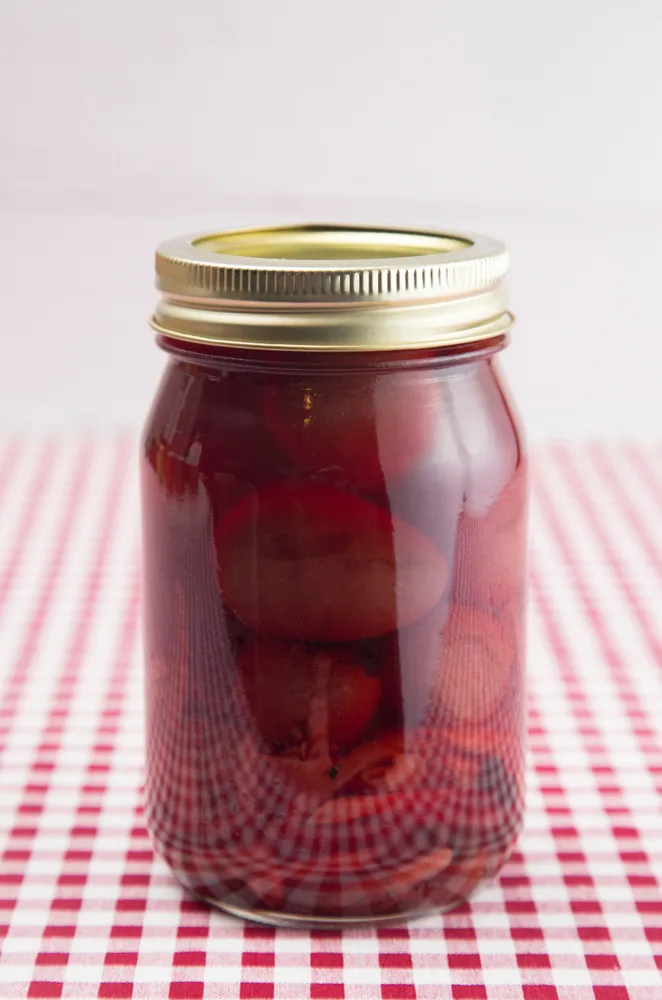
Pickling beets is easier than you think. All it takes is water, white vinegar, sugar, salt and, of course, beets. Onions are optional.
The process is straightforward and the rewards are incredibly lovely, if you happen to love beets.
Get to know how to safely can pickled beets, then harvest a few pounds or more to get started. You can also pick up some red beets from a farmers market. Remember to save the candy striped beets for eating fresh, when they are pickled their colors will fade.
14. Apple chutney
Moving beyond pickles, you will find jars, and jars, of chutney.
Chutney can be made out of nearly any kind of fruit, so go ahead and search for recipes related to the abundance you will harvest/purchase this summer.
Apple chutney is always a big hit in our household, appearing more times on the dining room table than applesauce. It is slightly spicy and aromatic, with hints of fennel and coriander seed. Simply perfect next to a skillet of fried potatoes.
15. Cherry chutney
If you desire an alternative to barbecue sauce, something that is red in color and more distinctive in flavor, I can think of nothing you will enjoy more than a jar of homemade sweet cherry chutney. Okay, maybe a jar of sweet cherry barbecue sauce…
If you find that chutney is still too sweet for your taste, try using sour cherries instead. Sour cherry chutney is incredibly tasty, and it is definitely something you cannot find in any store.
16. Tomato chutney
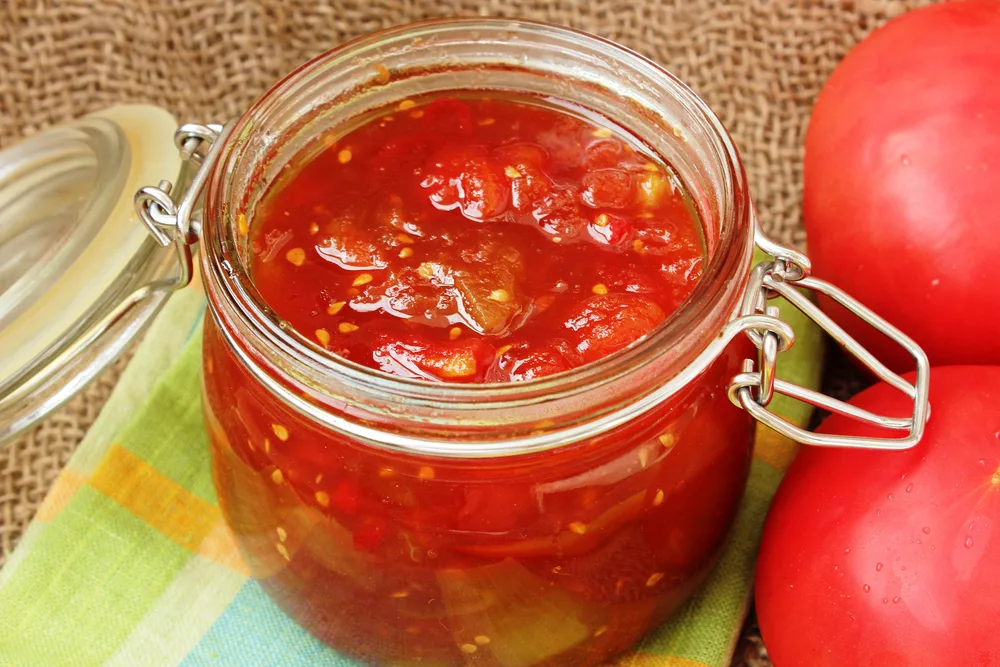
Of course, it is always reassuring to have jar after jar of canned tomatoes, tomato and/or spaghetti sauce on your pantry shelves. After all, tomatoes are likely a big part of your garden (if you have one) and an enjoyable part of your diet (if you have no aversion/allergy to them).
Related Reading: 26 Ways To Preserve A Bounty Of Tomatoes
Just about everyone likes a bite of tomato in one shape or form. Outside of eating tomatoes fresh, or on pizza, one other homemade canning project to make with tomatoes, is chutney.
Not too many people I know have tried it before, though if you are ready and willing to branch out and try new things, start here with this addictive tomato chutney recipe.
Sauces and condiments
When you start making your own handmade sauces and condiments at home, you will start to feel the abundance of the garden, and your life will feel plentiful in return.
Be grateful that you know how to do such clever things with your hands (washing, chopping, stirring, etc.), then go ahead and indulge in some familiar favorites.
If you have dried garden herbs to add to your sauces and condiments, consider that a delectable bonus.
17. Ketchup
There are a myriad of ways to preserve tomatoes, from canning to freezing, from dehydrating to fermenting. Within this, you are sure to find a few recipes to come back to.
If you have kids at home, of any age, and want to prove that homemade can be just as good – or even better! – than store-bought, you are going to have to learn how to make ketchup.
Your first time around of making ketchup, be sure to try more than one canning recipe. Experiment and find one that works the best with your tomatoes – variety does make a big difference.
How to Make Old Fashioned Ketchup: Preservative- and Additive-Free
Homemade Ketchup Recipe From Fresh Tomatoes
18. Mustard
While you are learning how to make ketchup, you may as well test your skills on making mustard. Do you even know how mustard is made?
If you’ve never made it before, nor have you watched someone whip a batch together, you are not alone.
Making mustard is not rocket science. We all have the basic kitchen skills required to make it. So, why aren’t we making it? At least for fresh eating, and potentially for canning and preserving as well.
When you are ready to try your hand at mustard making, check out this wholegrain mustard recipe for water bath canning.
If you enjoy life on the spicier side, consider adding a pinch of horseradish. It will knock your socks off!
19. Salsa
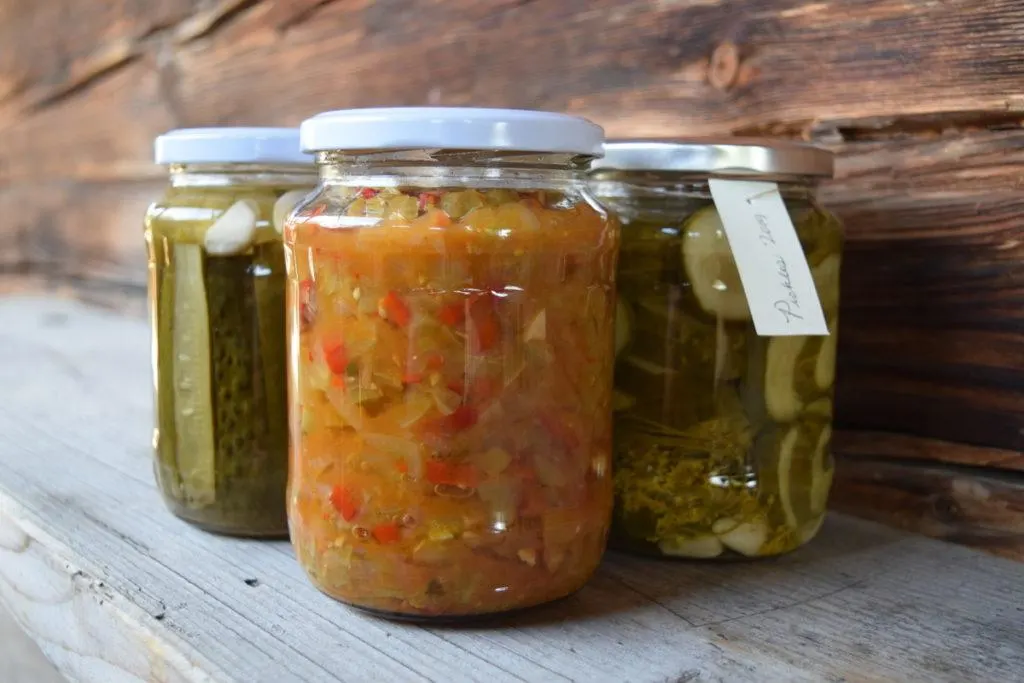
There are so many ways to preserve salsa, that it is hard to narrow it down to just a few. And with everyone claiming they have the best homemade salsa recipe, whom can you trust?
The simple answer is to trust your gut. Literally, and figuratively.
Which salsa recipe you choose, depends on the ingredients you have at hand.
If you have loads of tomatoes, onion, green bell peppers, jalapeños and spices, try this amazing salsa recipe.
Late into tomato season and you need to harvest green tomatoes before the first frost? Try this zingy green tomato salsa instead.
20. BBQ sauce
Last, but not least, is barbecue sauce.
I’ve had to learn how to make my own after spending more than fifteen years abroad. Even if you have store-bought options nearby, you may want to consider learning how to make your own barbecue sauce too. Working with the various recipes until you discover the flavors you absolutely love.
Then make sure to can the BBQ sauce properly. Providing yourself with a year’s worth of sauce stocked on your shelves, not the shelves of a superstore.
Gather your canning recipes beforehand and harvest your ingredients fresh, but don’t forget about stocking up on canning supplies.
Be prepared with a selection of canning jars and lids, far before the season starts. You never know when a bountiful harvest may just come your way!

Get the famous Rural Sprout newsletter delivered to your inbox.
Including Sunday ramblings from our editor, Tracey, as well as “What’s Up Wednesday” our roundup of what’s in season and new article updates and alerts.


